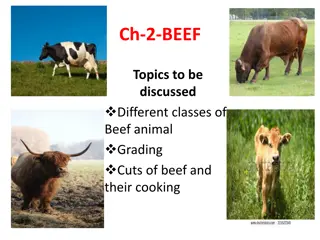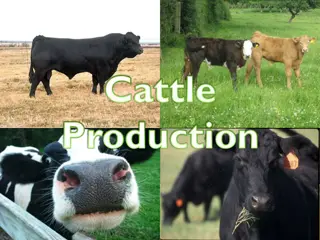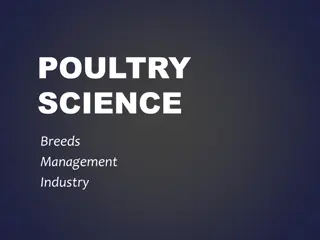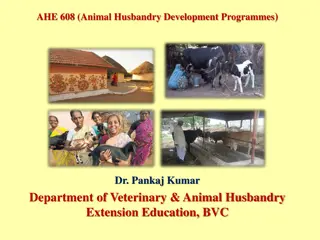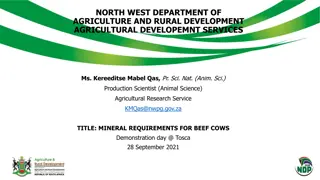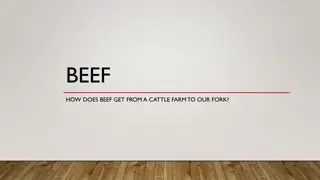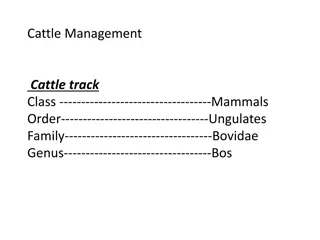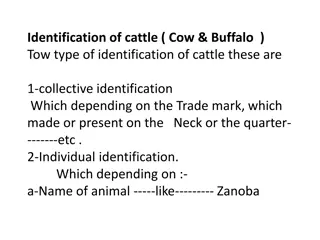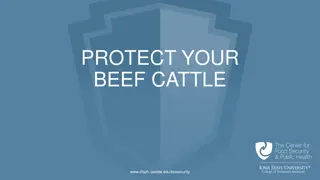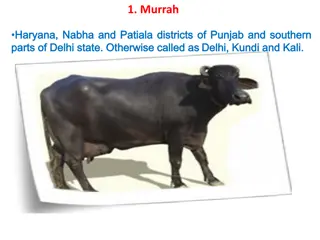Overview of Beef Cattle Breeds and Characteristics
In the United States, there are over 80 recognized breeds of beef cattle, each with its own advantages and disadvantages. British breeds like Angus and Hereford offer low birth weight and high fertility, while European breeds like Charolais and Simmental excel in growth rate and milk production. Other breeds like Shorthorn and Brahman have unique characteristics making them suitable for various purposes. Understanding these breed profiles is essential for successful cattle farming.
Download Presentation

Please find below an Image/Link to download the presentation.
The content on the website is provided AS IS for your information and personal use only. It may not be sold, licensed, or shared on other websites without obtaining consent from the author.If you encounter any issues during the download, it is possible that the publisher has removed the file from their server.
You are allowed to download the files provided on this website for personal or commercial use, subject to the condition that they are used lawfully. All files are the property of their respective owners.
The content on the website is provided AS IS for your information and personal use only. It may not be sold, licensed, or shared on other websites without obtaining consent from the author.
E N D
Presentation Transcript
In the United States there are more than 80 recognized breeds of beef cattle.
A breed is a group of animals of common descent, possessing distinctive characteristics that distinguish them from other groups within the same species.
When you examine the characteristics of any breed there are always some advantages and some disadvantages.
British Breeds: Angus, Hereford, Shorthorn Advantages Low birth weight High fertility Moderate milk production Moderate frame size Disadvantages Lower growth rate
European Breeds: Charolais, Gelbvieh, Maine-Anjou, Pinzgauer, Simmental, South Devon,Tarentaise Advantages High growth rate Increased dystocia Larger frame size Increased maintenance High milk production Disadvantages
Shorthorn PROFILE From England Color Red, red and white, or roan Size Mature Bulls: 1,000-1,300 lbs Mature Cows: 800-1,200 lbs Popularity Factors Dual purpose breed for milk and meat.
Charolais PROFILE From France Color White Size Mature Bulls: 2,800-3,300 lbs Mature Cows: 1,400-2,500 lbs Popularity Factors Long bodied large cattle. Heavily muscled.
Brahman PROFILE From India Color White to grey, red to black. Size Mature Bulls: 2,800-3,300 lbs Mature Cows: 1,400-2,500 lbs Popularity Factors Insect and heat resistant, able to survive on little, poor feed. Has sweat glands.
Texas Longhorn PROFILE From North America Color Diverse coloring Size Mature Bulls: 2,800-3,300 lbs Mature Cows: 1,400-2,500 lbs Popularity Factors Can eat very poor vegetation. Lean beef and really cool horns.
Popular Beef Cattle Breeds in Texas
Hereford Black and Red Angus Simmental
Hereford PROFILE From Hereford, England Color Red or Black with white head, legs, and underline. Size Mature Bulls: 2,000-2,500 lbs Mature Cows: 1,00-1600 lbs Popularity Factors Excellent mothers. Very adaptable to any environment, juicy tender meat. Very easy to handle.
Angus PROFILE From Scotland Color Black hair and skin or red hair and skin. Size Mature Bulls: 1,000-1,300 lbs Mature Cows: 800-1,200 lbs Popularity Factors Excellent mothers. Naturally no horns, and natural marbling for tasty, tender beef. Very easy to handle.
Simmental PROFILE From Switzerland, came to the United States in 1971 Color pale yellow-gold all the way to very dark red or black Size Mature Bulls: 2,200-2,800 lbs Mature Cows: 1,100-1,500 lbs Popularity Factors Gentle and large with heavy milk production. Very lean meat. Very easy to handle.
Additional Beef Cattle Information
Breeds of Beef Cattle There are approximately 250 breeds of cattle recognized throughout the world, and several hundreds of breeds that are not recognized. The exact count is impossible to determine because other breeds continue to be imported, and crossing existing breeds continuously creates new breeds.
Breed Characteristics The major characteristics for beef producers: Mature body size Milk production Age at puberty Environmental adaptability Rate and efficiency of gain Muscle expression Cutability Marbling
Mature Body Size: If various sizes of cattle are fed for the same length of time, cattle with a larger body size will have faster, more efficient gains, lower marbling, less fat, and improved cutablity. Mature cows weigh less than mature bulls. Larger mature size results in: Heifers being older and/or heavier at puberty Heavier birth weights (often associated with difficult calving) Faster rate of gain Heavier weaning weights
Milk Production The Main reason for increasing milk production in beef cattle is to increase weaning weights of calves. Heavy milk production can be bad Heavy milking cows often produce milk at the expense of their body functions (they get skinny) Thin females are less likely to come into heat and have a harder time getting pregnant Heavy milkers are slow to cycle which lengthens breeding interval and reduces general reproductive efficiency.
Muscle Expression Leaner meat means more muscle Most breeds that are ranked above average in muscle expression are also above average in size. One concern with beef producers is that muscularity appears to affect reproductive efficiency (calving difficulties with bigger calves).
Age at Puberty Age at puberty is important because cattle that reach puberty at an earlier age conceive at an earlier age. These cattle have the potential to have a long productive life (economically important to cattle producers) Age at puberty is linked to body size, milking potential, genetic classification, and environmental factors. Smaller cattle with higher milk yield have been known to mature earlier. Cattle exposed to harsh environmental conditions, whose nutritional requirements are not being met, reach puberty later.
Cutablity and Marbling Cutability is the percent of lean in a slaughter animal and is directly affected by an animal s muscle structure and directly related to nutrition. Marbling (intramuscular fat) is often referred to as taste fat. Cattle that mature early and have high milk yields are usually high in marbling.


